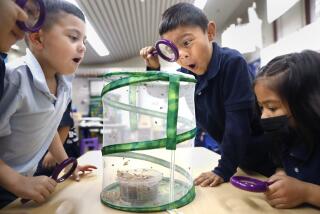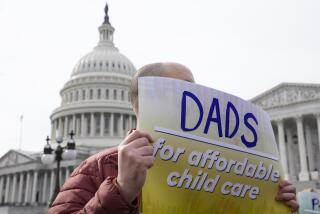Efforts to Improve Literacy to Focus on Child-Care Providers
- Share via
WASHINGTON — Federal officials and a coalition of private organizations are targeting a new group in their campaign to help American schoolchildren become better readers: the 13 million infants and toddlers who are now in day care.
The goal is to use a combination of federal seed money and new efforts by private nonprofit groups to train about 3 million child-care providers to develop critical literacy and pre-reading skills in the young children they deal with every day.
Nobody pretends that training child-care providers would be easy or quick.
If successful, however, the effort could substantially reduce the proportion of children--now estimated at 35%--who enter kindergarten unprepared to learn to read. A growing body of research shows that three-quarters or more of such children remain handicapped throughout their school careers.
“Day care is not just a parking place for kids,” said Joan Lombardi, a senior associate at Yale University’s Bush Institute in Child Development and Social Policy.
“It can be a good educational center if we make it so,” said Lombardi, who is attempting to build a network linking day-care organizations with reading readiness groups.
Secretary of Education Richard W. Riley echoed Lombardi’s views in a speech to a conference of reading groups here last week. Training day-care providers to develop pre-reading skills could “make a powerful difference in helping these preschoolers develop their language and literacy skills,” he said.
“We should not miss this opportunity.”
To encourage such training, the Clinton administration has proposed adding a section to the Elementary and Secondary Education Act providing a so-far unspecified amount of federal money to stimulate state and local agencies to begin establishing standards and pre-literacy training for day-care providers.
The provision, part of the act’s reauthorization bill, has been sidetracked by House Republicans but remains alive in the Senate. Its ultimate fate is uncertain.
The Education Department also plans to encourage at least some of the college students who serve as reading tutors under the federal work-study student aid program to focus on day-care centers.
In part, the push to give child-care providers a bigger role in preparing children to read is spurred by recent research on brain development. It suggests that the early years are more important than previously understood; without stimulation such as being read to by parents or others, beginning in infancy, children may not develop to their full potential, specialists say.
Learning rhymes, colors, songs and the alphabet at an early age also stimulates interest in reading, educators say, by helping youngsters understand that sounds and words are created by linking letters in certain combinations.
But many students receive such instruction relatively late, according to a federal report titled “Start Early, Finish Strong.”
“Elementary school teachers do not even meet children until well after key periods have passed for cognitive and language development,” the report said.
The effort to extend reading development into day care is also driven by the fact that so many children now spend so many of their waking hours in such care--even those whose mothers do not work outside the home.
About 60% of all children under the age of 6 who are not in kindergarten now receive day care, up from 21% in 1965, according to government statistics. That includes 45% of infants under the age of 1, as well as 84% of 5-year-olds--most of them in day-care centers, not private homes.
Moreover, young children are spending more hours in day care than they used to. Currently, preschoolers spend an average of 35 hours a week in day care if their mothers work outside the home, and children whose mothers do not have outside jobs average 20 hours a week in day care.
“Why in the world would we wait until they get to school to start preparing them to learn to read?” Lombardi asks.
Even with a modest beginning, the obstacles are large--but so is the potential payoff. To begin with, while some day-care centers have strong pre-reading programs, most day-care providers have little or no training in the field and many states have minimal or no requirements for such training.
Riley cited California as a leader in the field, and the “Start Early” report singled out the Gardner Children’s Center in San Jose as a model.
“For this bustling child-care center serving children from 6 weeks old through seventh grade, literacy is the foundation of all learning,” the report said, praising the center’s policy of daily story reading and regular visits by students to its Spanish language library.
Lombardi, with initial support from private foundations, is working to build bridges between child-care organizations and reading readiness groups. Many such groups exist, but they have not traditionally worked together because of philosophical differences and the suspicion of many child-care providers that educators look down on them.
Acknowledging the problem, Naomi Karp, director of the National Institute on Early Childhood Development and Education in the Department of Education, said: “People in public schools have to stop saying these children are coming to school in bad shape. They have to be proactive. . . . They need to beat on the table and be willing to put up resources and give moral support” to help child providers prepare their charges for school.
“If we’re serious about school reform, we have to start early,” Karp said.
More to Read
Sign up for Essential California
The most important California stories and recommendations in your inbox every morning.
You may occasionally receive promotional content from the Los Angeles Times.










